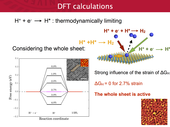Highlight
Catalytic Activity in Strained Chemically Exfoliated WS2 Nanosheets for Hydrogen Evolution
Achievement/Results
The ability to efficiently evolve hydrogen via electrocatalysis at low overpotentials holds tremendous promise for clean energy. Hydrogen evolution reaction (HER, 2H+ + 2e- → H2) can be easily achieved from water if a voltage above the thermodynamic potential of the HER is applied. Large overpotentials are energetically inefficient but can be lowered with expensive platinum based catalysts. Replacement of Pt with inexpensive, earth abundant electrocatalysts would be significantly beneficial for clean and efficient hydrogen evolution. Towards this end, promising HER characteristics have been reported using 2H (trigonal prismatic) XS2 (where X = Mo or W) nanoparticles with a high concentration of metallic edges as electrocatalysts. The key challenges for HER with XS2 are increasing the number and catalytic activity of active sites.
We have developed atomically thin nanosheets of chemically exfoliated WS2 as efficient catalysts for hydrogen evolution with very low overpotentials. Atomic-resolution transmission electron microscopy and spectroscopy analyses indicate that enhanced electrocatalytic activity of WS2 is associated with high concentration of strained metallic 1T (octahedral) phase in the as-exfoliated nanosheets. Density functional theory calculations reveal that the presence of strain in the 1T phase leads to an enhancement of the density of states at the Fermi level and increases the catalytic activity of the WS2 nanosheet. Our results suggest that chemically exfoliated WS2 nanosheets could be interesting catalysts for hydrogen evolution.
Address Goals
Realization of the “hydrogen economy” will require efficient and sustainable production of hydrogen. The scientific community has been actively searching for new electrocatalysts that decrease the overpotential of the HER as well as being earth abundant and inexpensive. Platinum is the most electroactive and electrochemically stable catalyst, making it challenging to find a suitable replacement. The identification ofXS2 as potential efficient catalysts for HER has opened up an exciting new path for the field.







